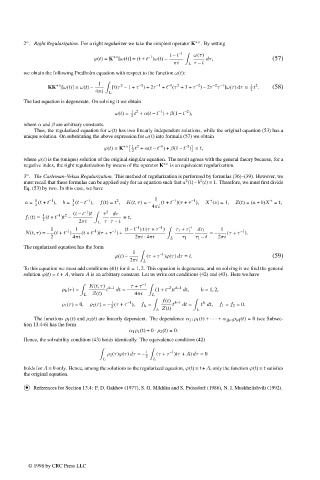Page 675 - Handbook Of Integral Equations
P. 675
◦
2 . Right Regularization. For a right regularizer we take the simplest operator K ∗◦ . By setting
t – t –1 ω(τ)
–1
ϕ(t)= K ∗◦ [ω(t)] ≡ (t + t )ω(t) – dτ, (57)
πi L τ – t
we obtain the following Fredholm equation with respect to the function ω(t):
1
–2
2
–2
–2 –1
–1
2
KK ∗◦ [ω(t)] ≡ ω(t) – [t(τ – 1+ τ )+2τ –1 + t (τ +3+ τ ) – 2τ τ ]ω(τ) dτ = 1 2 (58)
t .
4πi L 2
The last equation is degenerate. On solving it we obtain
t + α(t – t )+ β(1 – t ),
ω(t)= 1 2 –1 –2
2
where α and β are arbitrary constants.
Thus, the regularized equation for ω(t) has two linearly independent solutions, while the original equation (53) has a
unique solution. On substituting the above expression for ω(t) into formula (57) we obtain
t + α(t – t )+ β(1 – t ) = t,
ϕ(t)= K ∗◦ 1 2 –1 –2
2
where ϕ(t) is the (unique) solution of the original singular equation. The result agrees with the general theory because, for a
negative index, the right regularization by means of the operator K ∗◦ is an equivalent regularization.
3 . The Carleman–Vekua Regularization. This method of regularization is performed by formulas (36)–(39). However, we
◦
2
2
must recall that these formulas can be applied only for an equation such that a (t) – b (t) = 1. Therefore, we must first divide
Eq. (53) by two. In this case, we have
1
–1
–1
+
–1
–1
2
+
a = 1 (t + t ), b = 1 (t – t ), f(t)= t , K(t, τ)= – (t + t )(τ + τ ), X (z)=1, Z(t)=(a + b)X = t,
2 2 4πi
–1
(t – t )t τ 2 dτ
–1
2
f 1 (t)= 1 (t + t )t – = t,
2 2πi L τ τ – t
–1
–1
1 1 (t – t ) t (τ + τ ) τ 1 + τ –1 dτ 1 1
–1
–1
–1
–1
N(t, τ)= – (t + t ) (t + t )(τ + τ )+ 1 = – (τ + τ ).
2 4πi 2πi ⋅ 4πi L τ 1 τ 1 – t 2πi
The regularized equation has the form
1
–1
ϕ(t) – (τ + τ )ϕ(τ) dτ = t. (59)
2πi L
To this equation we must add conditions (41) for k = 1, 2. This equation is degenerate, and on solving it we find the general
solution ϕ(t)= t + A, where A is an arbitrary constant. Let us write out conditions (42) and (43). Here we have
–1
K(t, τ) τ + τ
–2
ρ k (τ)= t k–1 dt = – (1 + t )t k–1 dt, k =1, 2,
L Z(t) 4πi L
f(t)
1
–1
k
ρ 1 (τ)=0, ρ 2 (τ)= – (τ + τ ), f k = t k–1 dt = t dt, f 1 = f 2 =0.
2
L Z(t) L
The functions ρ 1 (t) and ρ 2 (t) are linearly dependent. The dependence α j1 ρ 1 (t)+ ··· + α j|ν| ρ |ν| (t) = 0 (see Subsec-
tion 13.4-6) has the form
α 1 ρ 1 (t)+0 ⋅ ρ 2 (t)=0.
Hence, the solvability condition (43) holds identically. The equivalence condition (42)
–1
ρ 2 (τ)ϕ(τ) dτ = – 1 (τ + τ )(τ + A) dτ =0
L 2 L
holds for A = 0 only. Hence, among the solutions to the regularized equation, ϕ(t)= t+A, only the function ϕ(t)= t satisfies
the original equation.
•
References for Section 13.4: F. D. Gakhov (1977), S. G. Mikhlin and S. Pr¨ ossdorf (1986), N. I. Muskhelishvili (1992).
© 1998 by CRC Press LLC
© 1998 by CRC Press LLC
Page 658

